Ben was a strong supporter of the Allied forces in World War One and firmly believed that Germany and the Central Alliance started the war. His feelings towards duty and military service most likely evolved from growing up in British Army barracks and his time spent fighting in the Second Boer War (1899-1902).
The Western Mail was a mainstream newspaper and supported the Australian war effort including the call for national conscription in Australia. Ben was a strong support of the 1916 and 1918 referendums on introducing conscription in Australia. Both referendums failed to pass, with only Western Australia and Tasmania voting for conscription both times. It was following the defeat of the second referendum that Strange published one of his most notable cartoons’ East is East and West is West’ which strongly criticises the result.
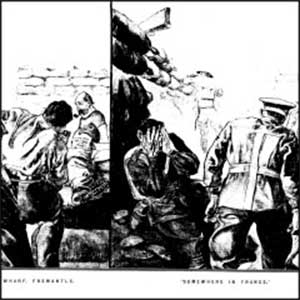
‘”Smoke-oh,” North Wharf, Fremantle. “Somewhere in France”’, Western Mail 4 May 1917. By 1917 the number of men enlisting to fight was in decline. It was not an uncommon practice for supporters of the war to try and shame men who had not yet enlisted, into enlisting. In this cartoon Ben Strange is targeting workers at the Fremantle wharfs, who would also be union members, portraying them as ‘slackers’ unlike the men who were fighting in France.
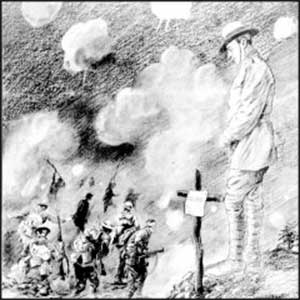
‘Lest We Forget’ Western Mail April 26 1918, Illustrated Section p3. This is the first cartoon drawn by Ben Strange that commemorates ANZAC Day, a nationwide commemoration that was still in its infancy.
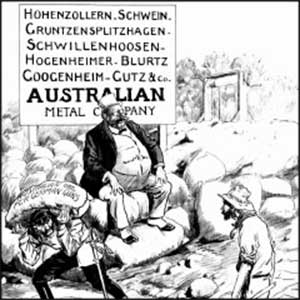
‘A Fool There Was’ Western Mail 30 July 1915. In this cartoon Ben Strange is showing outrage at the control of the Australian metal industry by German companies. The government quickly moved to pass laws breaking agreements between Australian mines and German companies.
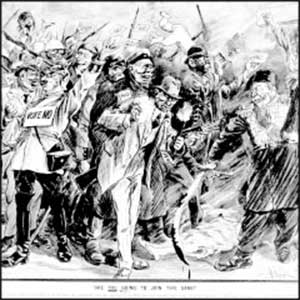
‘Are You Going To Join This Gang?’ Western Mail October 27 1916. Ben Strange demonstrating his support for the first referendum on conscription in Australia by claiming if you voted no you were a traitor to Australia. The cartoon references a story that a Canadian soldier was crucified by German forces during the Battle of Ypres in April 1915. Investigations by the British Army found no proof this ever occurred, though this did not stop the story, along with many other untrue stories about German atrocities from being used to stir up support for the War effort. The cartoon also targets the Independent Workers of the World (gentleman in a suit at the front with I.W.W ribbon) an international worker’s union who had strongly campaigned against conscription.

“East is East And West is West” --- Kipling - Western Mail 4 January 1918
Some of the anti leaders domiciled in this State profess surprise at the overwhelming “Yes” vote in Western Australia. One of the anti’s said that at one time this State could boast of leading democracy in Australia, but the result of the last two referendums shows that we are lagging behind in both democracy and humanity, and are out of step with Australian sentiment.
This cartoon was published following the defeat of the second Australian referendum on conscription. It was inspired by a statement made by Alex McCallum, a leading anti-conscriptionist, following the 1917 referendum that Western Australia was lagging behind the Eastern States in democracy and humanity and was out of step with the national sentiment by twice voting Yes for conscription. The quote is from the opening line of The Ballad of East and West by Rudyard Kipling, first published in 1889.
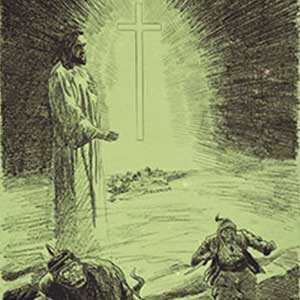
The Triumph of the Cross - Western Mail 30 November 1917
The “Cologne Gazette,” the organ of the German Government, declares that the capture of Jerusalem by the British is of serious political importance.
This cartoon is celebrating the news that General Edmund Allenby’s Egyptian Expeditionary Force was moving into position to capture Jerusalem from the Ottoman Empire. Allenby would capture the city on December 7, a week after the cartoon was published. The image of Jesus Christ and the Christian Cross looking down on the fleeing enemy is implying a number of messages from the evil Ottomans and their beastly German allies about to be driven out; to celebrating that for the first time since 1517 the holy city was again under Christian control.

